Table of Contents
What is Mendel’s Law of Independent Assortment?
- Mendel’s Law of Independent Assortment is a fundamental principle in the field of genetics that describes how alleles of different genes are inherited within sexually reproducing organisms. This law, formulated based on the outcomes of Gregor Mendel’s experiments with pea plants, reveals a crucial aspect of genetic inheritance.
- At its core, the Law of Independent Assortment states that the alleles of two or more different genes are sorted into gametes independently of each other. In simpler terms, the inheritance of an allele for one gene does not influence the inheritance of an allele for another gene. This concept highlights the remarkable autonomy with which different genetic traits are transmitted from one generation to the next.
- During sexual reproduction, the process of meiosis plays a key role in the segregation and distribution of genetic material. As chromosomes are separated into multiple gametes, genes located on these chromosomes can undergo a process known as crossing-over, where homologous portions of maternal and paternal chromosomes can exchange segments. This mechanism further ensures the independent assortment of genes, even those located on the same chromosome.
- Mendel’s experiments consistently demonstrated that the traits of offspring exhibited a variety of combinations that were distinct from those of their parents. This phenomenon led him to formulate the Law of Independent Assortment. This principle emphasizes that genes inherited from the maternal and paternal sources are assorted independently, generating a wide array of genetic combinations in offspring.
- To illustrate, consider the scenario where one gamete ends up with all maternal chromosomes, while another gamete contains a mixture of both maternal and paternal chromosomes. This assortment pattern extends to the genes located on these chromosomes, thereby introducing significant diversity through various combinations of genes.
- It’s important to note that there are instances where genes are not assorted completely randomly. Linked genes, which are genes located on the same chromosome, are an exception. However, even in the case of linked genes, the process of crossing-over during meiosis ensures that these genes get rearranged. Through the exchange of homologous segments between maternal and paternal chromosomes, linked genes also experience independent assortment.
- In conclusion, Mendel’s Law of Independent Assortment is a cornerstone of genetics, explaining how genes and their alleles are inherited independently within sexually reproducing organisms. This principle underscores the intricate mechanisms of meiosis and crossing-over, which result in the diverse genetic combinations observed in offspring. By shedding light on the inheritance of traits, this law has significantly contributed to our understanding of genetic diversity and inheritance patterns.
Mendel’s Law of Independent Assortment Definition
Mendel’s Law of Independent Assortment states that different genes and their alleles are inherited independently within sexually reproducing organisms.
Characteristics and Principle of Mendel’s Law of Independent Assortment
Mendel’s Law of Independent Assortment is a fundamental principle governing genetic inheritance, which is intricately tied to the process of meiosis during sexual reproduction. This law outlines several key characteristics and principles that contribute to the diverse characteristics observed in offspring:
- Meiosis and Haploid Gametes: The law of independent assortment is rooted in the process of meiosis, a specialized type of cell division that leads to the formation of gametes (sperm and egg cells). During meiosis, the diploid chromosomes of parents are separated, resulting in haploid gametes with half the genetic material.
- Chromosome Assortment: Importantly, the assortment of chromosomes into haploid gametes occurs independently of one another. Each chromosome’s fate is determined in a random manner, unaffected by the assortment of other chromosomes. This leads to potential variations in offspring characteristics.
- Random Distribution: The random distribution of chromosomes to gametes means that chromosomes from the same parental source can end up in different gametes. This results in the potential for offspring to inherit a mix of genetic material from both parents, contributing to individual diversity.
- Recombination and Independent Rearrangement: The process of recombination during meiosis further contributes to the independent assortment of genes. Recombination involves the exchange of genetic segments between homologous chromosomes. This creates novel combinations of alleles, leading to an even greater assortment of genes and traits in offspring.
- Example Illustration: A classic example that illustrates the principle of independent assortment involves a cross between homozygous pea plants with different traits. Consider a cross between plants with yellow round seeds (genotype YYRR) and plants with green wrinkled seeds (genotype yyrr). The resulting offspring can have genotypes such as YyRR, YyRr, YYRr, YYrr, Yyrr, yyRR, and yyRr. This demonstrates that alleles for different traits assort independently, producing various combinations of traits.
- Combinations of Alleles: The law of independent assortment shows that even though alleles for different traits might be linked in the parental generation, they can express themselves in diverse combinations in the offspring. This principle reinforces the concept that inheritance is not solely tied to the parental combination of alleles.
In essence, Mendel’s Law of Independent Assortment emphasizes the crucial role of meiosis and recombination in shaping genetic diversity. This law explains how genes for different traits are assorted independently, contributing to the variety of characteristics observed in sexually reproducing organisms.
Examples of Mendel’s Law of Independent Assortment
1. Dihybrid Cross in Drosophila
An insightful illustration of independent assortment can be observed through a dihybrid cross involving Drosophila, commonly known as fruit flies. In this experiment, Mendelian principles elucidate the manner in which distinct characteristics segregate and assort independently during meiosis, leading to diverse phenotypic outcomes in the offspring.
Consider the dihybrid cross between two sets of Drosophila parents:
- Parent 1: Homozygous for long-winged and black-bodied traits.
- Parent 2: Vestigial-winged and grey-bodied.
Here, long wing and grey body are dominant traits, while vestigial wing and black body are recessive traits.
Key points about this dihybrid cross:
- Dominant Traits and Meiosis: In this cross, the dominant traits—long wing and grey body—are present in one set of parents, while the other set carries recessive traits. During meiosis, the chromosomes carrying these traits segregate and recombine independently, leading to a random assortment of these characters in the offspring.
- Independent Inheritance: Despite the fact that the two characters are found together in the parental generation, they inherit independently in the offspring. This phenomenon underscores the principle of independent assortment, which is a cornerstone of Mendelian genetics.
- Phenotypic Outcomes: The resulting F2 generation of offspring displays four distinct phenotypes due to the independent assortment of the traits. These phenotypes are:
- Long-winged and grey-bodied
- Long-winged and black-bodied
- Vestigial-winged and grey-bodied
- Vestigial-winged and black-bodied
Through this dihybrid cross, it becomes evident that the inheritance of one trait is not linked to the inheritance of the other. The random assortment of alleles during meiosis allows for a broad range of genetic combinations, leading to the diverse phenotypic outcomes observed in the offspring.
In conclusion, the dihybrid cross involving Drosophila provides a tangible example of Mendel’s principle of independent assortment. It underscores how two distinct traits can be inherited independently, leading to a multitude of possible genetic combinations and phenotypic expressions in the offspring. This experiment further solidifies our understanding of the intricacies of genetic inheritance and the essential role that meiosis plays in generating genetic diversity.
2. Mendel’s work on pea plant
Gregor Mendel’s groundbreaking work with pea plants laid the foundation for modern genetics, and his experiments provided key insights into the principles of inheritance. One of his most significant contributions was his study of dihybrid crosses, exemplified by his investigation involving pea plants with different traits.
Mendel’s experiment centered around a dihybrid cross between two homozygous pea plants with distinct characteristics: one had yellow round seeds (genotype YYRR), and the other had green wrinkled seeds (genotype yyrr). Here’s how Mendel’s work unfolded:
- Meiosis and Gamete Formation: Mendel’s experiment was rooted in the understanding of meiosis, where chromosome pairs separate during cell division. In the parents, only half of the genes are transported to the gametes. For the yellow round seed parent, gametes had the possible genotypes YR, and for the green wrinkled seed parent, the possible genotype was yr.
- First Generation (F1): By crossing the parents, Mendel obtained F1 hybrids with the YyRr genotype. The dominant alleles Y (for yellow color) and R (for roundness) were expressed, leading to the F1 hybrids displaying the phenotype of yellow round seeds.
- Allele Segregation: The alleles in the F1 hybrids could be divided into four distinct combinations: Y for yellow color, y for green color, R for roundness, and r for wrinkledness.
- Combinations and Phenotypes: These four alleles could combine in various ways, giving rise to different genotypes and corresponding phenotypes. This diversity was a direct result of independent assortment during meiosis and the combination of alleles from each parent.
- Second Generation (F2): Mendel’s further crossings led to the formation of four types of gametes: YR, Yr, yR, and yr. These gametes fused to create the F2 generation, which consisted of sixteen individuals.
- Phenotypic Ratio: The most remarkable outcome of Mendel’s experiment was the phenotypic ratio observed in the F2 generation: 9 yellow round : 3 yellow wrinkled : 3 green round : 1 green wrinkled. This ratio illustrated that the characteristics of seed color (yellow/green) and seed shape (round/wrinkled) were inherited independently of each other.
- Independent Inheritance and Dominance: Mendel’s experiment provided strong evidence that the traits were inherited independently, meaning that the presence of one trait did not affect the inheritance of the other. Additionally, the dominant alleles were expressed in the phenotype, while the recessive alleles were hidden in the presence of dominant alleles.
In summary, Mendel’s meticulous experiments with pea plants, particularly his dihybrid cross involving seed color and seed shape traits, revealed the principles of independent assortment, allele segregation, and dominance. His work laid the groundwork for understanding inheritance patterns and established the basis for the field of genetics.
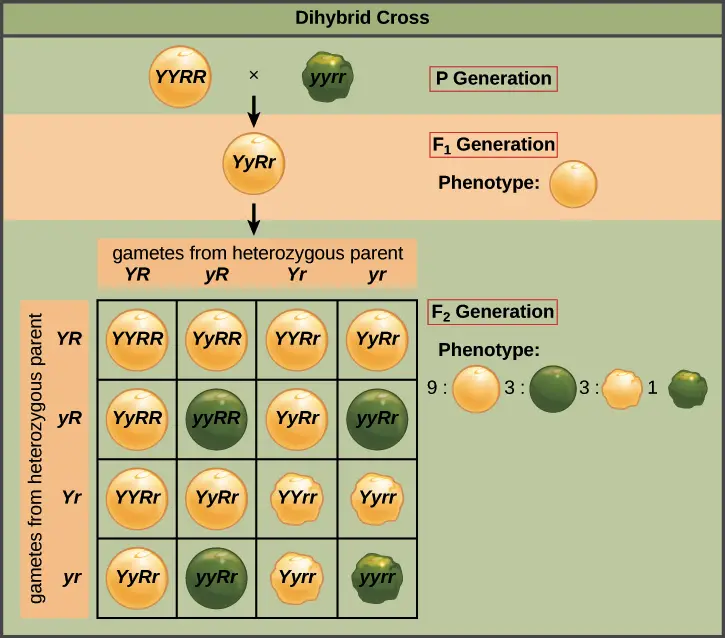
When Does Independent Assortment Occur?
- Independent assortment occurs during the process of meiosis, a specialized form of cell division that plays a pivotal role in sexual reproduction. This process ensures the generation of genetically diverse gamete cells, which are essential for the creation of offspring with unique genetic combinations.
- Meiosis is akin to mitosis in many respects, but its end result differs significantly. While mitosis leads to the creation of genetically identical daughter cells, meiosis gives rise to gamete cells that have half the amount of DNA as regular diploid cells. These gametes are considered haploid. This reduction in DNA content is a crucial step in sexual reproduction, as it enables two gamete cells – one from each parent – to unite and form a diploid zygote, containing all the genetic information required to develop into a new organism.
- The concept of independent assortment is closely linked to another foundational principle of genetics, the Law of Segregation. According to the Law of Segregation, during meiosis, the two different copies of each gene, known as alleles, are separated into different gamete cells. This separation ensures that each gamete carries only one allele for each gene.
- Independent assortment, however, focuses on the random separation of maternal and paternal sources of DNA. Unlike the Law of Segregation, which pertains to the individual alleles of a single gene, the law of independent assortment deals with the distribution of different genes located on different chromosomes. The segregation of chromosomes during meiosis occurs in a manner that is independent of how other chromosomes are segregating.
- In the process of independent assortment, the maternal and paternal chromosomes are divided at random, contributing to the genetic diversity of the resulting gametes. This randomness arises from the way chromosomes align and segregate during the first stage of meiosis. As a result, a gamete might inherit a specific gene’s allele from either the maternal or paternal source in an unpredictable fashion.
- In summary, independent assortment is a crucial mechanism that occurs during meiosis, where maternal and paternal sources of DNA are divided at random. This process, combined with the Law of Segregation, ensures the generation of genetically diverse gametes. Ultimately, the intricate interplay of independent assortment and segregation allows for the creation of offspring with unique genetic combinations, contributing to the diversity and adaptability of species.
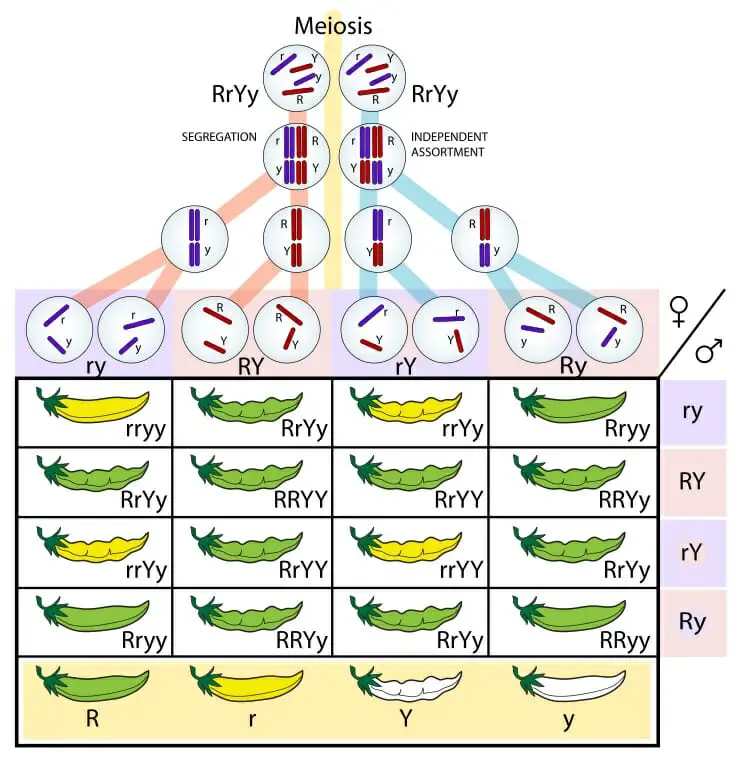
Independent assortment vs. linkage
The comparison between independent assortment and linkage reveals fundamental differences in how genes are inherited and how they can potentially be physically associated on chromosomes. Here’s a breakdown of both concepts and how they contrast:
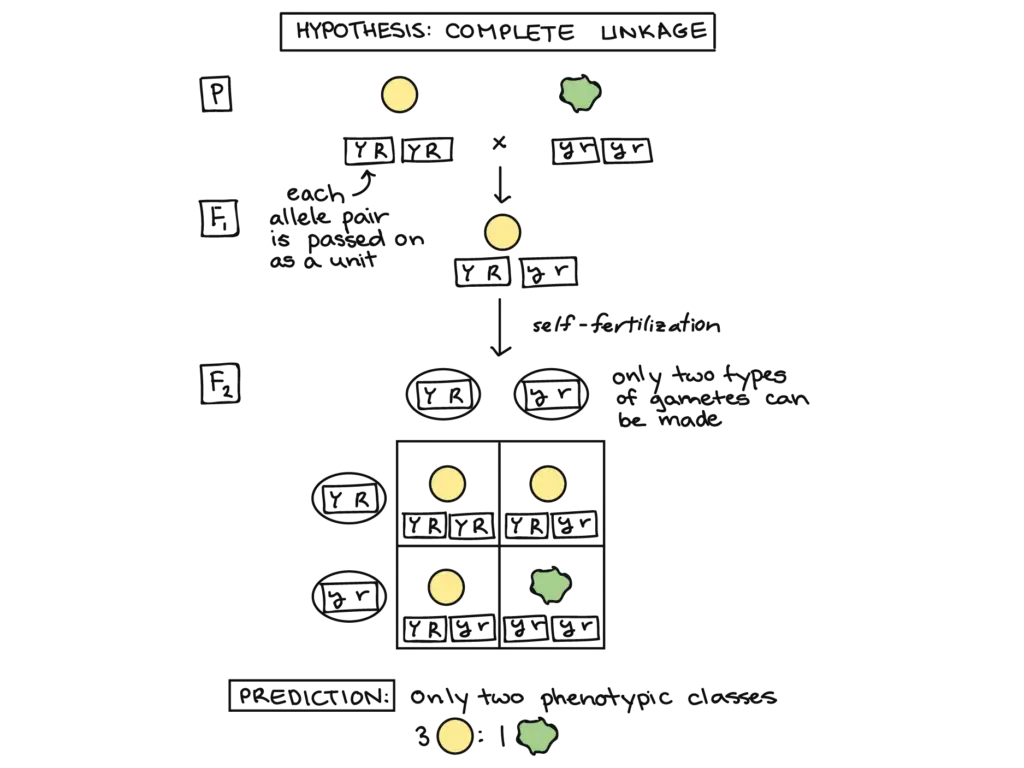
Independent Assortment: Independent assortment is a principle proposed by Mendel that states that alleles of different genes assort or segregate independently during gamete formation. This concept is based on the behavior of different gene pairs on non-homologous chromosomes. During meiosis, homologous chromosomes segregate into different gametes independently of one another, allowing for diverse genetic combinations in offspring.
Linkage: Linkage refers to the tendency of genes located on the same chromosome to be inherited together as a unit, rather than assorting independently. This occurs because these genes are physically close to each other on the same chromosome and are less likely to be separated during crossing-over in meiosis.
The scenario you described involves genes for seed color and seed shape in plants. In the extreme case of complete linkage, these genes could be physically stuck together on the same chromosome. This would result in these genes always being inherited together, and the alleles for seed color and seed shape would not assort independently, as they would be unable to segregate into different gametes during meiosis.
Contrasting the Two Concepts:
- Independent Assortment: If genes assort independently, they segregate into gametes without regard to the behavior of other genes on different chromosomes. This leads to a variety of genetic combinations and can result in a 9:3:3:1 phenotypic ratio in offspring, as observed in Mendel’s classic dihybrid crosses.
- Linkage: If genes are linked, they are inherited together and do not follow the principle of independent assortment. This can lead to a deviation from the expected ratios if the linked genes are considered together.
In the context of your provided content, the illustration and explanation revolve around the hypothetical scenario of complete linkage between genes for seed color and seed shape in plants. However, Mendel’s actual observations and outcomes did not align with the expectations of complete linkage. His experimental results yielded a phenotypic ratio that suggested independent assortment of these traits, providing strong evidence that genes on different chromosomes assort independently during gamete formation.
In conclusion, the concepts of independent assortment and linkage highlight the mechanisms by which genes are inherited and can lead to different phenotypic outcomes. Independent assortment involves the random assortment of alleles on non-homologous chromosomes, while linkage describes the tendency of genes on the same chromosome to be inherited together. Mendel’s pioneering experiments provided empirical evidence for the principle of independent assortment, which has become a cornerstone of modern genetics.
Reason for independent assortment
The phenomenon of independent assortment, which is a cornerstone of genetic diversity, can be traced back to the physical arrangement of genes on chromosomes. This understanding became more refined over time, revealing the reasons behind the occurrence of independent assortment.
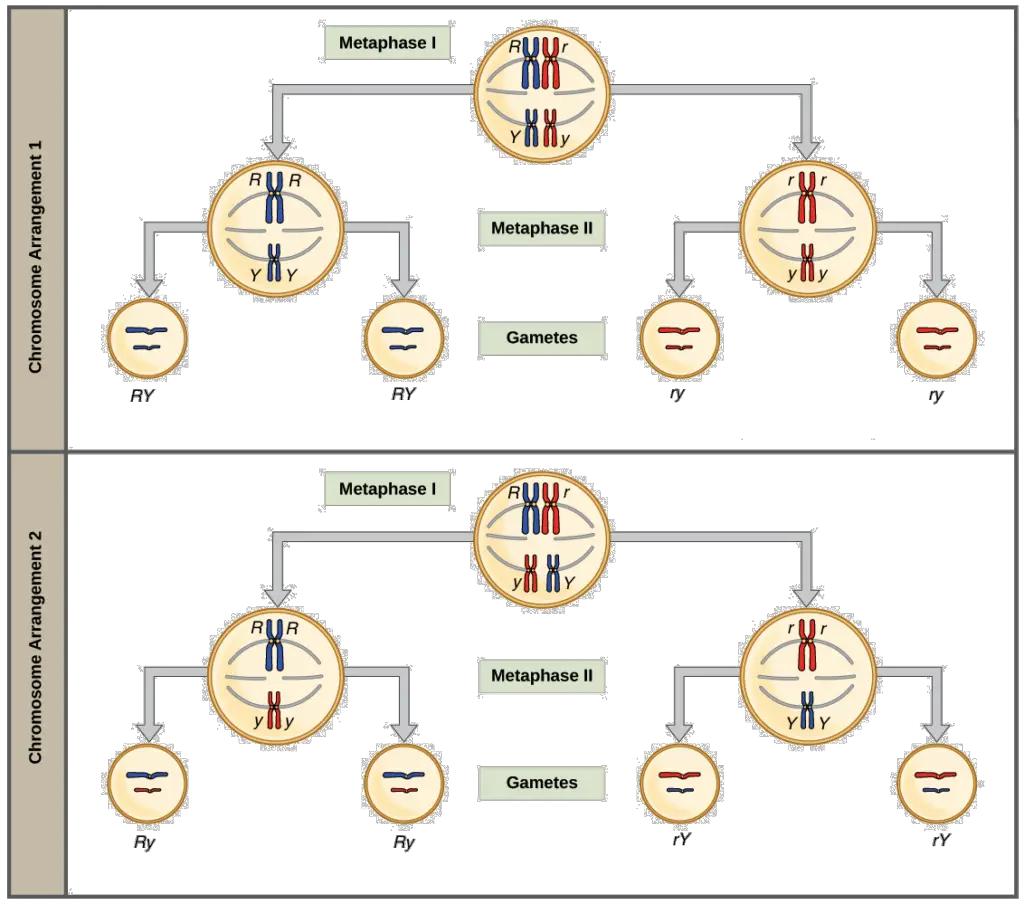
Chromosomal Basis of Genes: Nearly half a century after Mendel’s experiments, the discovery of chromosomes as carriers of genetic information laid the foundation for comprehending the mechanism of independent assortment. Genes, the units of hereditary information, were found to be physically located on chromosomes. Each gene is present in two copies (alleles) on the homologous chromosomes of a pair. These pairs are similar but not identical, with one chromosome inherited from each parent.

Meiosis and Chromosome Orientation: The physical basis of independent assortment becomes evident during meiosis I, the initial phase of gamete formation. At this stage, homologous chromosome pairs align in a random orientation along the cell’s equatorial plane before they separate. This orientation is crucial, as it determines which alleles will end up in the resulting gametes. Because of this randomness in alignment, different combinations of “mom” and “dad” chromosomes (and their corresponding alleles) are possible.
For instance, in a dihybrid cross involving two genes—say, genes for seed color and seed shape—there are multiple possible alignments of homologous chromosomes. This results in gametes carrying various combinations of alleles from each parent, leading to genetic diversity in the offspring.

Illustration of Independent Assortment: In a simplified example, imagine homologous chromosome pairs—one set from the mother and another from the father—lining up during metaphase I of meiosis. There are two potential chromosome arrangements: one where the “mom” chromosomes stick together and the “dad” chromosomes do the same, and another where the “mom” and “dad” chromosomes mix. If meiosis occurs repeatedly, as it does in organisms like pea plants, both arrangements will happen with equal frequency. This leads to the formation of different classes of gametes with equal probability.
Exceptions to Independent Assortment: While genes located on different chromosomes and genes that are far apart on the same chromosome can assort independently due to random orientation during meiosis, gene pairs situated closely on the same chromosome may not exhibit independent assortment. Instead, these genes tend to be inherited together as a unit. This phenomenon is known as genetic linkage, and it results from the limited occurrence of crossing over, where homologous chromosome segments exchange during meiosis. Genetic linkage contradicts the principle of independent assortment and is explored in further detail in related articles and discussions.
In conclusion, the physical arrangement of genes on chromosomes and the random orientation of homologous chromosome pairs during meiosis provide the basis for independent assortment. This process contributes significantly to genetic diversity by generating various combinations of alleles in offspring. While independent assortment is a prevailing phenomenon, genetic linkage demonstrates that there are instances when genes do not assort independently due to their physical proximity on chromosomes.
Limitations of Mendel’s Law of Independent Assortment
Mendel’s Law of Independent Assortment, while a fundamental principle in explaining genetic inheritance, is not without its limitations. While the law elegantly captures the behavior of many genes, there are certain scenarios where it does not accurately reflect genetic processes. Some of these limitations include:
- Linked Genes: The law of independent assortment does not hold true for genes that are located on the same chromosome, particularly when they are close together or on the same locus. Such genes are referred to as linked genes and tend to be inherited together rather than assorting independently. This phenomenon is a result of the limited recombination between closely linked genes during crossing-over in meiosis.
- Incomplete Dominance and Codominance: The law of independent assortment assumes that one allele of a gene is dominant over the other, leading to a clear expression of the dominant trait. However, in cases of incomplete dominance or codominance, where neither allele is completely dominant and both contribute to the phenotype, the law’s application becomes limited. These situations can result in complex inheritance patterns not accounted for by the simple principles of the law.
- Polygenic Traits: The law of independent assortment is not applicable to traits that are influenced by multiple genes, known as polygenic traits. These traits, such as human height or skin color, are controlled by the combined effects of several genes working together. The interaction of these genes makes it difficult to apply the law of independent assortment to predict the outcomes accurately.
- Environmental Influences: The law of independent assortment assumes that genetic traits are the sole determinant of phenotypic outcomes. However, in reality, environmental factors can also play a significant role in shaping the expression of certain traits. These environmental influences can lead to variations in phenotypes that are not solely explained by genetic inheritance.
In essence, while Mendel’s Law of Independent Assortment provides a foundational understanding of genetic inheritance, its applicability is limited by the complexities of genetics and biology. The law’s assumptions are not always met in real-world scenarios, especially in cases involving linked genes, incomplete dominance, codominance, and polygenic traits. As our knowledge of genetics advances, these limitations underscore the need for a more nuanced and comprehensive understanding of the mechanisms that govern inheritance and trait expression.
Mendel’s Law of Independent Assortment Mindmap
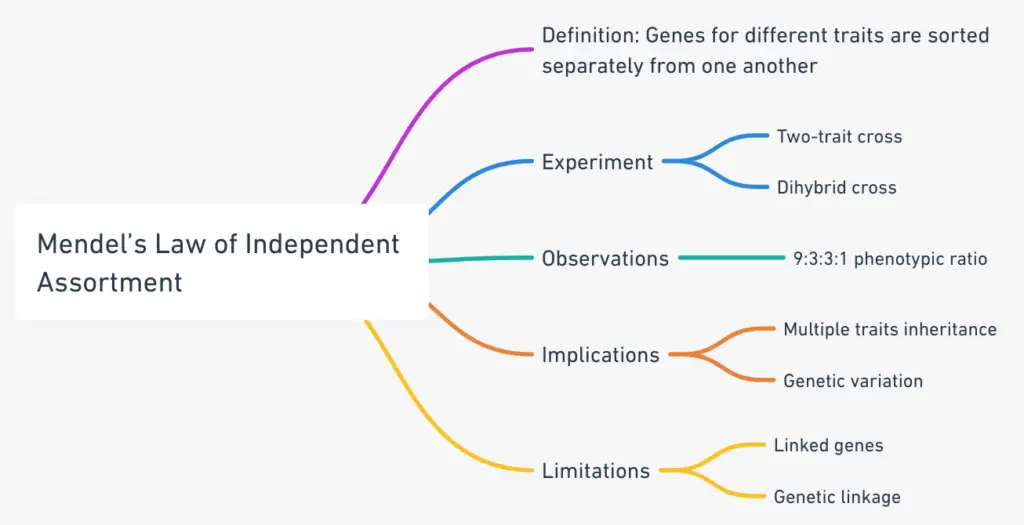
FAQ
What is Mendel’s Law of Independent Assortment?
Mendel’s Law of Independent Assortment states that different genes located on different chromosomes segregate, or assort, into gametes independently of each other during meiosis.
What is the significance of the Law of Independent Assortment?
This law explains how traits controlled by different genes are inherited independently, leading to genetic diversity and the variation observed in offspring.
When does independent assortment occur?
Independent assortment occurs during meiosis, specifically during metaphase I when homologous chromosome pairs align randomly at the cell’s equatorial plane.
What does the term “linked genes” mean in relation to independent assortment?
Linked genes are genes located close together on the same chromosome. Unlike genes on separate chromosomes, linked genes are less likely to assort independently because they tend to be inherited together.
Can genes on the same chromosome ever exhibit independent assortment?
Genes on the same chromosome can exhibit independent assortment if they are far apart from each other. This is due to the occurrence of crossing over, where segments of homologous chromosomes exchange during meiosis.
How does independent assortment lead to genetic diversity?
Independent assortment allows different combinations of alleles from various genes to come together in gametes. When these gametes fuse during fertilization, they create offspring with unique genetic compositions.
What is the relationship between independent assortment and the Law of Segregation?
The Law of Independent Assortment complements the Law of Segregation. While segregation deals with the separation of alleles for a single gene, independent assortment focuses on the random distribution of different gene pairs into gametes.
Does the Law of Independent Assortment apply to genes exhibiting incomplete dominance or codominance?
No, the Law of Independent Assortment does not apply in cases of incomplete dominance or codominance, where both alleles contribute to the phenotype. These situations lead to more complex inheritance patterns.
What does it mean when genes assort independently according to Mendel’s law?
Genes assorting independently means that the inheritance of one gene’s alleles doesn’t affect the inheritance of alleles from another gene. They segregate into gametes in a manner unaffected by other genes.
Are there any exceptions to the Law of Independent Assortment?
Yes, genetic linkage is an exception where genes that are physically close on the same chromosome tend to be inherited together due to a lower likelihood of crossing over. Additionally, interactions between genes or epistasis can affect the expected ratios in some cases.
References
- Mendel’s Law of Independent Assortment. (2022, June 9). Boundless. https://bio.libretexts.org/@go/page/13272
- Biologydictionary.net Editors. (2017, January 20). Law of Independent Assortment. Retrieved from https://biologydictionary.net/law-of-independent-assortment/
- https://www.khanacademy.org/science/ap-biology/heredity/mendelian-genetics-ap/a/the-law-of-independent-assortment
- https://unacademy.com/content/neet-ug/study-material/biology/law-of-independent-assortment/
- https://www.biologyonline.com/dictionary/independent-assortment
- https://www.studysmarter.co.uk/explanations/biology/heredity/law-of-independent-assortment/
- https://www.nature.com/scitable/definition/principle-of-independent-assortment-law-of-independent-302/


